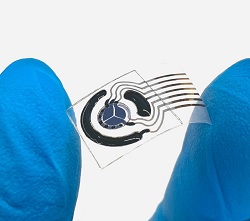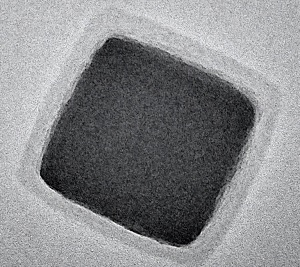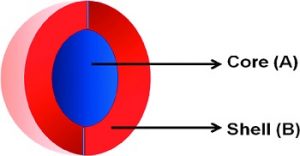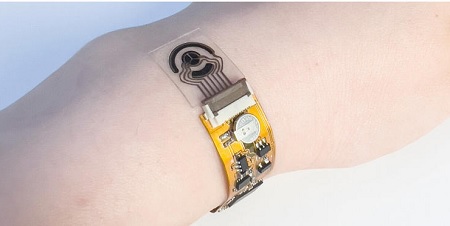The following article which was originally published on Phys.org.is selected for pimi.ir readers due to importance of improvement in polymer’s nonoparticles . However, based on our policy it has been more completed by addition of extra hyperlinks (shown in BOLD fonts).
***************************************

The future of medicine may very well lie in the personalization of health care—knowing exactly what an individual needs and then delivering just the right mix of nutrients, metabolites, and medications, if necessary, to stabilize and improve their condition. To make this possible, physicians first need a way to continuously measure and monitor certain biomarkers of health.
To that end, a team of Caltech engineers has developed a technique for inkjet printing arrays of special nanoparticles (above image) that enables the mass production of long-lasting wearable sweat sensors. These sensors could be used to monitor a variety of biomarkers, such as

vitamins, hormones, metabolites, and medications, in real time, providing patients and their physicians with the ability to continually follow changes in the levels of those molecules.

Wearable biosensors that incorporate the new nanoparticles have been successfully used to monitor metabolites in patients suffering from long COVID and the levels of chemotherapy drugs in cancer patients at City of Hope in Duarte, California.
“These are just two examples of what is possible,” says Wei Gao, a professor of medical engineering in the Andrew and Peggy Cherng Department of Medical Engineering at Caltech. “There are many chronic conditions and their biomarkers that these sensors now give us the possibility to monitor continuously and noninvasively,” says Gao, who is the corresponding author on a paper in the journal Nature Materials describing the new technique.
Gao and his team describe the nanoparticles as core–shell cubic nanoparticles. The cubes are formed in a solution that includes the molecule that the researchers want to track—for example, vitamin C. As the monomers spontaneously assemble to form a polymer, the target molecule—vitamin C—is trapped inside the cubic nanoparticles.
 A transmission electron microscopy image of a core–shell cubic nanoparticle (left image). The new core-shell nanoparticles are highly versatile and are used in printing sensor arrays that measure levels of multiple amino acids, metabolites, hormones, or drugs in sweat or bodily fluids simply by using multiple nanoparticle “inks” in a single array. For example, in the work described in the paper, the researchers printed out nanoparticles that bind to vitamin C along with other nanoparticles that bind to the amino acid tryptophan and creatinine, a biomarker commonly measured to see how well the kidneys are working. All of the nanoparticles were combined into one sensor that was then mass produced. These three molecules are of interest in studies of patients with long COVID. (Credit: Caltech).
A transmission electron microscopy image of a core–shell cubic nanoparticle (left image). The new core-shell nanoparticles are highly versatile and are used in printing sensor arrays that measure levels of multiple amino acids, metabolites, hormones, or drugs in sweat or bodily fluids simply by using multiple nanoparticle “inks” in a single array. For example, in the work described in the paper, the researchers printed out nanoparticles that bind to vitamin C along with other nanoparticles that bind to the amino acid tryptophan and creatinine, a biomarker commonly measured to see how well the kidneys are working. All of the nanoparticles were combined into one sensor that was then mass produced. These three molecules are of interest in studies of patients with long COVID. (Credit: Caltech).Related video: Nanotechnology: A New Frontier (Aperture)
Returning to the vitamin C example, fluid will come into contact with the NiHCF core as long as the vitamin C–shaped holes are unoccupied, and this will generate an electrical signal.
When vitamin C molecules come into contact with the polymer, however, they slip into those holes, thus preventing sweat or other bodily fluids from making contact with the core. This weakens the electrical signal. The strength of the electrical signal, then, reveals just how much vitamin C is present.
“This core is critical. The nickel hexacyanoferrate core is highly stable, even in biological fluids, making these sensors ideal for long-term measurement,” says Gao, who is also a Heritage Medical Research Institute Investigator and a Ronald and JoAnne Willens Scholar.

The new core-shell nanoparticles are highly versatile and are used in printing sensor arrays that measure levels of multiple amino acids, metabolites, hormones, or drugs in sweat or bodily fluids simply by using multiple nanoparticle “inks” in a single array.
For example, in the work described in the paper, the researchers printed out nanoparticles that bind to vitamin C along with other nanoparticles that bind to the amino acid tryptophan and creatinine, a biomarker commonly measured to see how well the kidneys are working.
All of the nanoparticles were combined into one sensor that was then mass produced. These three molecules are of interest in studies of patients with long COVID.
Similarly, the researchers printed out nanoparticles-based wearable sensors that were specific to three different antitumor drugs on individual sensors that were then tested on cancer patients at City of Hope.
In the paper, the team also showed that the nanoparticles can be used to print sensors that can be implanted just below the skin to precisely monitor drug levels in the body.
More information: Printable molecule-selective core–shell nanoparticles for wearable and implantable sensing, Nature Materials (2025). DOI: 10.1038/s41563-024-02096-4. nature.com/articles/s41563-024-02096-4
Provided by California Institute of Technology












